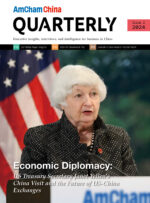Bridging Borders: How Cultural Exchange Fuels Trade Prosperity
By Bin Huang
Discover how cultural exchange fuels trade prosperity. Bin Huang, a key member of AmCham China’s Northeast Chapter Executive Committee, explores the transformative impact of cross-cultural understanding on global supply chains. With insights from AmCham China member companies and an examination of historical precedents, Bin explores why nurturing cultural exchange is vital for navigating today’s complex trade landscape.

Bin Huang’s career spans business development, government relations, and data analytics. As an American, he brings over a decade of experience at the Dalian Commodities Exchange, a key Chinese financial government agency. Bin has worked closely with the US Department of Commerce and the American Chambers of Commerce to enhance the presence of the foreign business community in China. He has also collaborated with private Chinese businesses, providing advice on cross-border expansions. Known for his ability to listen and analyze, Bin has developed innovative, win-win solutions for his partners. He holds a degree in Applied Mathematics from Columbia University, where he attended on a full scholarship.
Photo courtesy of Bin Huang
Supply chains have evolved from local production and vertical integration to offshoring and outsourcing. This decade, as the narrative of global commerce unfolds, a significant shift is underway. Companies are increasingly diversifying their supply sources, beginning with uniform components from different country sources. Chinese factories are also adapting by expanding beyond their national borders to remain competitive. With these added dimensions to the international commerce matrix, the importance of cross-cultural understanding is set to ascend to unprecedented prominence for reliable scaled production. This commercial evolution is a proactive step towards strengthening resilience across society. In this context, elevating cultural exchange is a mandatory priority for success in the coming years. Going forward, we will see corporations that adopt resilient trade frameworks optimizing profits and operations by reducing misunderstandings across all levels. Through a blend of historical examples, trends observed by member companies of the American Chambers of Commerce in China, and future possibilities, we will explore why, in the next decade, fluid engagement across cultures will not just be beneficial but essential for mutual economic prosperity and trade success.
The Silk Road’s Legacy of Prosperity and Exchange
The Silk Road, a historic network of trade routes connecting East Asia to the Mediterranean, is a prime example of how cultural exchanges and trade can create a self-reinforcing loop of economic growth and prosperity. As a result of prosperous trade, cities along the Silk Road like Samarkand – now in modern-day Uzbekistan – and Xi’an in China, developed into bustling multicultural centers with rich economic and cultural dynamism. These multilingual hotspots, where traders and residents spoke Persian, Arabic, Turkish, Mandarin, and other Central Asian languages, were not just a cultural phenomenon but a business necessity. The linguistic diversity facilitated new and smoother transactions, significantly enhancing trade depth and breadth.
Corporate Growth Strategies Leveraging Cultural Exchange
Cultural exchange and international trade dynamics move in corresponding tides. They are powerful tools that can be strategically utilized. Both corporate strategies and government initiatives play crucial roles in leveraging these exchanges to enhance economic growth and trade. By fostering mutual understanding, respect, and cooperation, cultural exchanges can significantly reduce trade barriers, open up new markets, and raise quality standards, thereby enhancing both qualitative and quantitative gains.
Forming strategic partnerships with companies in other countries facilitates smoother entry into new markets by leveraging local expertise and established networks. These partnerships often materialize through joint ventures or reciprocal arrangements, such as employee exchange programs, which promote cultural exchange and mutual understanding.
Cultural exchanges are particularly valuable as they equip business leaders, negotiators, and employees with the necessary cultural competence needed to navigate social complexities with empathy and respect.
Moreover, these partnerships allow companies to combine strengths, share risks, and innovate together. By pooling resources and expertise, companies can achieve synergies that would be difficult to attain independently. For instance, a local partner can offer invaluable insights into consumer behavior and regulatory environments, while the international partner can provide advanced technologies and global best practices.
Japanese automotive assembly factories have established long-term partnerships with local suppliers, creating an integrated ecosystem within Dalian’s Development Zone. This strategic collaboration has been instrumental in transitioning from producing combustion engine forklifts to electric forklifts, aligning with the global shift towards environmental sustainability.
This transition has enabled multinational factories to modernize and stay competitive while playing a crucial role in preserving the local economy. By shifting to electric forklift production, jobs were safeguarded and potential bankruptcies among local businesses were averted. The continuous demand for components and services from local suppliers ensured these businesses remained viable and thrived alongside the evolving product lines of multinational enterprises.
Furthermore, foreign leadership in electric forklift production has had a ripple effect, fostering innovation and adaptation among local suppliers. These suppliers have had the opportunity to learn and transition into the green economy, acquiring new skills and capabilities that are increasingly valuable in today’s market. This not only benefits direct stakeholders but also contributes to the broader economic development of the region by embedding advanced, environmentally friendly manufacturing practices into the local industrial fabric.
The integrated ecosystem developed through these partnerships exemplifies the significant advantages of international collaboration. It underscores how multinational companies can drive local economic resilience and growth while advancing their strategic goals.
Building Trust and Cooperation
Trust is a fundamental element of successful trade relationships. Cultural exchanges often involve shared experiences, joint projects, and educational programs that build personal and institutional trust. The US-China Sister Cities program, which pairs cities from the United States with cities in China, fosters cultural and economic ties.
People exchange between the US and China has become more frequent after the “Sunny Land” dialogue. Hewlett Packard Enterprise (HPE) played a crucial role in strengthening these ties by collaborating with public sectors, private sectors, and NGOs. HPE welcomed the Shanghai Government Delegation to The HP Garage, the birthplace of Silicon Valley in California, to celebrate the 45th anniversary of the San Francisco-Shanghai Sister City relationship in May 2024. Additionally, HPE hosted the Dalian Government Delegation at their Customer Innovation Center in Houston during Cera Week in March 2024. This renewed collaboration underscored the importance of building trust and fostering cooperation, setting a positive tone for future partnerships in trade, investment, and innovation across cities.
Education and Intercultural Competency
Dr. Richard Swann, Head of Dalian American International School and Chair of the Northeast Chapter Executive Committee, emphasizes the critical role of intercultural competencies in international business. He explains:
“Building a foundation for intercultural competencies is crucial in meeting the demands of international business. The importance of international and bilingual education from kindergarten through high school graduation cannot be overstated.
“Employing teaching and administrative staff from diverse countries brings a multicultural mindset and the ability to engage across cultural boundaries. This diversity enriches the educational environment and fosters intercultural understanding.
“Students from multicultural backgrounds benefit from experiencing international curriculum models that emphasize intercultural citizenship and international mindedness. This prepares them for overseas tertiary education and equips them with the skills needed for global interactions. Bilingual school programs based on national curricula aligned with international standards offer host country nationals the opportunity to prepare for intercultural experiences.
“Intercultural educational preparation is essential for developing collaboration, higher-order thinking, service learning, and the ability to apply imagination and innovation across various contexts. These skills are critical for success in a globalized world.
“International and bilingual schools engage with host country communities through various means, including education bureaus, ministries of foreign affairs, employment bureaus, tourism, embassy, and consular missions. This engagement with governmental and legal infrastructure strengthens intercultural ties and supports the development of a globally competent workforce” (Swann, 2024).
Moreover, a new generation of business leaders is emerging, bridging Eastern and Western education and business practices. Students who have received education at institutions like Dalian American International School are now joining their family businesses after completing their studies in North American universities. This cohort, self-identified as 厂二代 (chǎng èr dài), meaning “second generation manufacturers,” actively engages in expanding their family businesses by leveraging their cross-cultural competencies.
These young leaders utilize their education and experiences to work effectively with Western clients, both within China and internationally. Their proficiency in navigating Western business practices, combined with their understanding of Chinese culture, positions them uniquely to drive international business growth.
With renewed collaboration between national and city-level governments in the West and China, facilitated by AmCham China, and the academic and cultural bridge provided to the incoming generation of business leaders, these efforts contribute not only to individual business success but also to stronger economic ties and increased trust between the regions.
Facilitating Market Entry and Expansion
Cultural exchange programs can provide businesses with reduced employee training hours when entering new markets or expanding in existing ones. These programs help employees understand local behavior, regulatory environments, and potential business risks.
Epoch International, a high-tech design and manufacturing company and AmCham China member, has successfully leveraged cultural understanding to thrive as a multinational enterprise. Founded in 1993 by Foad and Ladon Ghalili, who come from diverse cultural backgrounds and grew up in different countries, Epoch International was among the earliest foreign in the region.
Their diverse cultural experiences enabled Epoch International to seamlessly navigate various markets, efficiently operating in China, India, and the US. This geographical versatility gave the company a competitive edge, especially as customers adopted resilient supply chain strategies. Epoch met customer needs by implementing internal training programs across regions, ensuring employees adhered to operational standards.
Epoch’s unique management structure facilitated rapid expansion and integration of new locations, minimizing startup time for new factories while maintaining production efficiency and quality standards. The founders’ adaptability has been crucial to Epoch International’s sustained success and growth.
Benefits for US and China Economies
Looking ahead, the trajectory of global economic prosperity will increasingly depend on cultural exchange programs.
Economic Growth and Job Creation: Effective cultural exchange programs can lead to trade agreements that spur economic growth and create jobs. For instance, after the establishment of direct educational exchanges under the US-China Phase One trade deal, sectors such as agriculture, automotive, and services saw a boost, leading to economic benefits in both countries.
Sustainability Initiatives: Both nations have expressed commitments to sustainable development. Cultural exchanges, such as the Green Revolution led by the United States Agency for International Development (USAID) and the Consultative Group on International Agricultural Research (CGIAR), improved seed varieties to boost crop resilience and productivity in various countries. Similar cooperation in green energy can accelerate sustainable technology development.
Health and Biotechnology: The COVID-19 pandemic underscored the importance of international collaboration in health and science. By increasing cultural exchanges in these fields, the US and China can accelerate the development of medical technologies and public health strategies, paving the way for advancements that could define health care standards worldwide.
Creative Industries: The United States and China are major players in the global entertainment and creative industries. Movie collaborations have proved beneficial for both sides. Expanding cultural exchanges in media can lead to faster economic returns and enhanced cultural understanding.
The imperative for increased cultural exchanges between countries is clear. Such programs are not just friendly formalities; they are necessities for the sustained economic prosperity of the world.
Policymakers, educators, and business leaders in both the US and China should lead the expansion of cultural exchange programs. From the Silk Road to modern-day trade, committing to expanding the pathways of commerce and exchange is a fundamental principle for mutual benefits and global peace.

This article is from the AmCham China Quarterly Magazine (Issue 2, 2024). To access the entire publication for free, sign up on our member portal here.

